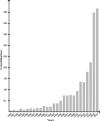DisProt: the Database of Disordered Proteins
- PMID: 17145717
- PMCID: PMC1751543
- DOI: 10.1093/nar/gkl893
DisProt: the Database of Disordered Proteins
Abstract
The Database of Protein Disorder (DisProt) links structure and function information for intrinsically disordered proteins (IDPs). Intrinsically disordered proteins do not form a fixed three-dimensional structure under physiological conditions, either in their entireties or in segments or regions. We define IDP as a protein that contains at least one experimentally determined disordered region. Although lacking fixed structure, IDPs and regions carry out important biological functions, being typically involved in regulation, signaling and control. Such functions can involve high-specificity low-affinity interactions, the multiple binding of one protein to many partners and the multiple binding of many proteins to one partner. These three features are all enabled and enhanced by protein intrinsic disorder. One of the major hindrances in the study of IDPs has been the lack of organized information. DisProt was developed to enable IDP research by collecting and organizing knowledge regarding the experimental characterization and the functional associations of IDPs. In addition to being a unique source of biological information, DisProt opens doors for a plethora of bioinformatics studies. DisProt is openly available at http://www.disprot.org.
Figures



References
-
- Fischer E. Einfluss der configuration auf die wirkung derenzyme. Ber. Dt. Chem. Ges. 1894;27:2985–2993.
-
- Koshland D.E., Jr, Ray W.J., Jr, Erwin M.J. Protein structure and enzyme action. Fed. Proc. 1958;17:1145–1150. - PubMed
-
- Landsteiner D.P. The Specificity of Serological Reactions. New York: Dover; 1936.
-
- Pauling L. A theory of the structure and process of formation of antibodies. J. Am. Chem. Soc. 1940;62:2643–2657.
Publication types
MeSH terms
Substances
Grants and funding
LinkOut - more resources
Full Text Sources
Other Literature Sources

